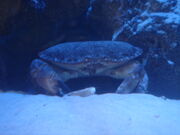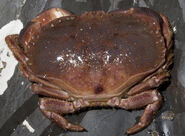
Edible Crab - http://www.andycowley.info/shore-life/index.html
The Edible Crab (Cancer pagurus), can weigh up to 12kg and with a claw span of up to a metre, this is Britain's largest crab. Its powerful pincers are able to exert hundreds of kilos of pressure. This crab can live up to 20 years.
Description[]
The carapace of C. pagurus adults is a reddish-brown colour, while in young specimens it is purple-brown. It occasionally bears white patches, and is marked along the front edge with nine rounded lobes, resembling a pie crust. Males typically have a carapace 60 millimetres (2.4 in) long, and females 98 mm (4 in) long, although they may reach up to 150 mm (6 in) long in exceptional cases. Carapace width is typically 150 mm (6 in), or exceptionally up to 250 mm (10 in). A fold of the carapace extends ventrally to constitute a branchial chamber where the gills lie.
From the front, the antennae and antennules are visible. Beside these there are the orbits in which the eyes are situated. The mouthparts comprise three pairs of maxillipeds, behind which there are a pair of maxillae, a pair of maxillules, and finally the mandibles.
In common with most crabs, the abdomen folded under the thorax and shows a sexual dimorphism: in males it is comparatively narrow, whereas in the female it is wider.
Life cycle[]
Reproduction occurs in winter; the male captures the female and holds her under himself until she moults. Internal fertilisation takes place before the hardening of the new carapace, with the aid of two abdominal appendages (gonopods). After mating, the female retreats to a pit on the sea floor to lay her eggs. Between 250,000 and 3,000,000 fertilised eggs are held under the female's abdomen for up to eight months until they hatch.
The first developmental stage after hatching is a planktonic larva (1 mm) called the zoea that

Edible Crab - WWC Archives
develops into a postlarva (megalopa), and finally a juvenile. The first juvenile stage is characterised by a well developed abdomen, which will, in time, become reduced in size and folded under the sternum. Juveniles settle to the sea floor in the intertidal zone, where they stay until they reach a carapace width of 60–70 mm (2.4–2.8 in) and then migrate to deeper water. The growth rate in males slows from an increase in carapace width of 10 mm per year before it is eight years old, to 2 mm per year thereafter. Females grow at about half the rate of males, probably due to the energetic demands of egg laying. Sexual maturity is reached at a carapace width of 12.7 cm (5.0 in) in females, and 11 cm (4.3 in) in males. Longevity is typically 25–30 years, although exceptional individuals may live for up to 100 years.
Distribution and ecology[]
Cancer pagurus is abundant throughout the northeast Atlantic as far as Norway in the north and northern Africa in the south, on mixed coarse grounds, mud and sand from shallow sublittoral to about 100 metres (330 ft). Unconfirmed reports suggest that C. pagurus may also occur in the Mediterranean Sea and Black Sea. It is frequently found inhabiting cracks and holes in rocks but occasionally also in open areas. Smaller specimens may be found under rocks in the littoral zone.
Adult C. pagurus are nocturnal, hiding buried in the substrate during the day, but foraging up to 50 metres (160 ft) from their hideouts at night. Their diet includes a variety of crustaceans and molluscs . It may stalk or ambush motile prey, and may dig large pits to reach buried molluscs. The main predator of Cancer pagurus is the octopus, which will even attack them inside the crab pots that fishermen use to trap them.




